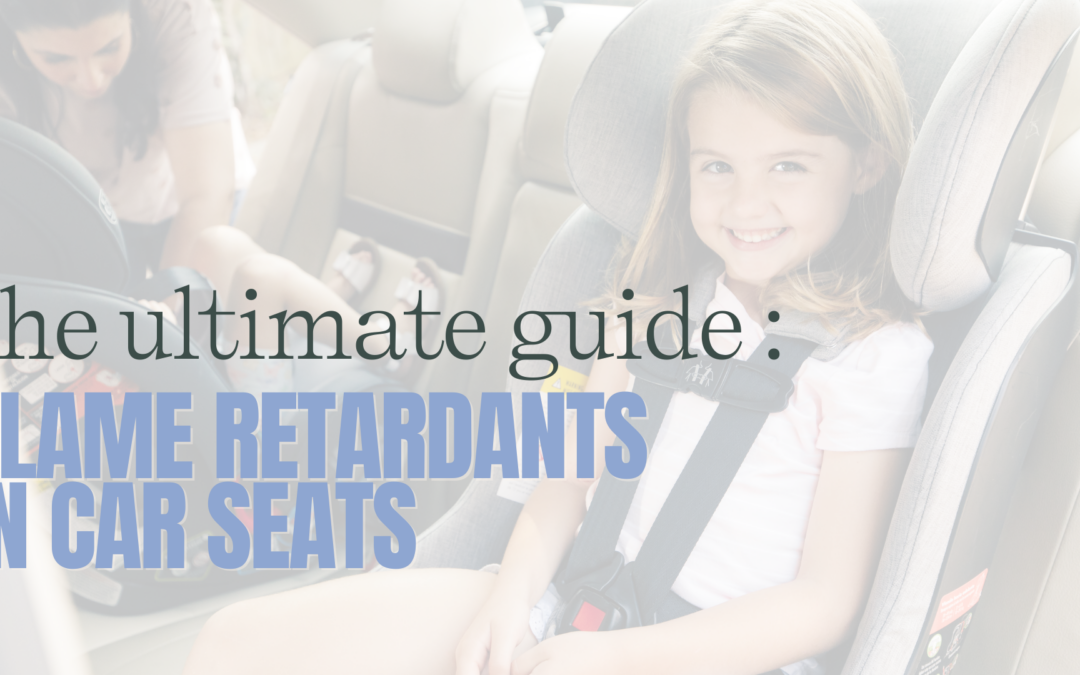When it comes to the safety of our little ones, nothing is more crucial than ensuring they are protected while on the road. A significant part of this protection comes from the design of car seats, which must adhere to stringent regulations to keep children safe. One such regulation is the flammability requirement. In this article, we’ll explore how manufacturers meet this requirement, the role of flame retardants, and the growing trend toward flame-retardant-free fabric options.
The Ultimate Guide To Flame Retardants In Car Seats
Meeting Flammability Requirements
One standard that car seat manufacturers in the U.S. and Canada must comply with involves resistance to flammability. The flammability requirement for car seats was added to FMVSS 213 (Federal Motor Vehicle Safety Standard 213) in the United States in 1971. This requirement was introduced to improve the safety of car seats and reduce the risk of fires in the event of a car crash. It was also to reduce the risk of fire caused by the use of cigarettes. The addition of the flammability requirement aimed to ensure that car seats would not contribute to the spread of fires inside a vehicle, thereby enhancing overall safety for passengers, including children seated in car seats.
To meet this requirement, many manufacturers incorporate chemicals known as flame retardants. These chemicals are designed to slow down the burning process and provide additional time for occupants to escape in the event of a fire.
However, not all manufacturers exclusively use these chemicals. Some have adopted naturally flame-resistant materials like wool to meet flammability standards. Wool’s inherent properties offer an effective, environmentally friendly alternative that eliminates the need for added chemicals. This is especially important for parents who have health concerns about chemical flame retardants.
State-Level Bans and PFAS Chemicals
The most commonly used flame retardant in car seats and other products is Per- and Polyfluorinated Substances (PFAS). Due to growing concerns about the potential environmental and health risks associated with certain flame retardants, like bromine, some states in the USA have implemented regulations to ban their use. These regulations reflect a move toward more responsible manufacturing practices and are pushing the industry to explore safer alternatives. As of this article, Massachusetts has banned certain chemicals in car seats from January 2022, and California’s law took effect in July 2023. These regulations are aimed at protecting consumers and the environment from potentially harmful chemicals. This kind of ban will require manufacturers to develop seats that conform to the requirements so that their seats can be sold in those states. We are seeing more and more manufacturers adding flame-retardant-free fabric options to their line-up already.
Flame Retardants Beyond Children’s Car Seats
It’s essential to recognize that flame retardants are not just limited to car seats. In fact, they are present in many parts of our vehicles, including the upholstery. In addition, they can be found in everyday items such as children’s clothing, mattresses, furniture, and carpets. While there is minimal evidence to suggest significant health issues from exposure to these chemicals, the widespread use of flame retardants does raise questions about long-term effects. Manufacturers are working to develop safer alternatives and some have already begun offering flame retardant-free (fr-free) options for car seats.
flame retardant-free Fabric Options
Due to consumer demand for chemical-free options, some manufacturers have developed flame-retardant-free fabric options for car seats. In fact, Nuna is currently the only manufacturer with 100% of their seats being free of flame-retardant chemicals. Britax is working on making their product line up completely free of added flame retardants as well. In addition, there are six other manufacturers who have at least one flame-retardant-free car seat option available. Many manufacturers, like Graco and Safety 1st, have yet to offer car seats made without flame-retardant chemicals. You can also find all the current offerings in the table below. In the table below we list the ones we recommend with a few details for each!
Car Seat Brands with Flame-Retardant Fabric
Infant Car Seats
Britax Willow and Britax Willow S
Britax’s newest infant seats come with Clicktight technology in the base for an easy seat belt installation! The Britax Willow is currently only available as part of a travel system, while the Willow S is available separately and has an anti-rebound bar on the base.
Read the Britax Willow S full review here.
Chicco KeyFit 30 and Chicco KeyFit 35
Both seats have bases with easy-to-use lower anchors for a tight installation. The KeyFit 35 also has an anti-rebound bar on the base, is slightly narrower, and it has a no-rethread harness.
Clek Liing
This seat has rigid lower anchors and a load leg. We also have a full review of this seat here. Clek Liing installl YouTube Video here.
Maxi Cosi Mico Luxe+
This seat has a load leg, which is an added safety feature. It also features self-ratcheting lower anchors on the base for easy installation.
Nuna Pipa RX and Nuna Pipa Urbn
Both of these seats have rigid lower anchors for quick installation. But the Pipa RX has a base and the Urbn does not. We also have a full review of the Pipa RX here and YouTube Videos here. The Pipa Urbn is only available as part of a travel system. But it’s a great option for parents who do not own a car, travel a lot, or have many people who may need to drive the baby around.
Convertible Car Seats
Britax Marathon, Britax Poplar Britax Advocate, and Britax One4Life
All four of these seats have Clicktight technology which allows for a quick seat belt installation. Britax Marathon and Advocate have been discontinued, but there are still some left in stock. Both have 40 pounds limits for rear-facing. In addition, Britax One4Life (review here) and Poplar (full review here.) have a 50 lbs rear-facing limits and the One4Life adds a high back booster mode as well.
Chicco NextFit Max and Chicco OneFit
Chicco NextFit Max has a 50 lbs rear-facing limit, while the OneFit’s is 40 lbs. But the OneFit has a taller harness height, a taller standing height limit for the forward-facing harness mode (54″), and it has a high back booster mode. Click here to read our review of the Chicco NextFit Max.
Clek Foonf and Clek Fllo
Both of these seats have 50 lbs rear-facing limits and an anti-rebound bar. But the Foonf has rigid lower anchors for forward-facing and the seats have different recline mechanisms. We have a full review of Clek Foonf here.
Cybex Sirona S
This is a swivel seat that has 50 lbs/49″ limits for rear-facing. It has a load leg and an anti-rebound bar as well. Although the seat has high rear-facing limits, we do not recommend it for kids who are above average height. The headrest is quite short and may be outgrown far before the child reaches the limits. (read full review here)
Evenflo Gold Revolve Extend
This is a swivel seat that has rear-facing, forward-facing, and high-back booster modes. The rear-facing mode has a 50 lbs limit. We have a full review here.
Maxi Cosi Romi
This seat is essentially the same as Cosco Scenera Next, which is one of our favorite travel seats. But this version adds flame-retardant-free fabric and harness covers.
Nuna Revv, Nuna Rava, and Nuna Exec
The Nuna Revv is a swivel seat that has 43″/40 lbs limits for both rear and forward-facing. Nuna Rava and Nuna Exec both have 50 lbs rear-facing limits. Nuna Exec has an anti-rebound bar and a high-back booster mode. All 3 seats are very compact in rear-facing mode.
Uppababy Knox
This seat can be challenging to install. But it does have a rear-facing tether, which is an added safety feature. It also has a 45 lbs rear-facing limit and it can be very compact rear-facing as well.
Forward-Facing Seats
Britax Grow With You Clicktight and Britax Grow With You Clicktight Plus
Both of these are easy to install with the seat belt, thanks to the ClickTight mechanism. The Plus version is much wider as it has additional side impact protection. But both have a tall harness height and make long-lasting high back boosters as well with 120 lbs/63″ limits.
Chicco MyFit
With a 54″ standing height limit in harness mode coupled with a tall harness height, Chicco MyFit is one of the longest-lasting harness options on that market. We have a full review of the seat here.
Booster Seats
Britax HighPoint
This seat has high back and backless modes, both of which have 120 lbs/63″ limits. The high back mode has a tall headrest, making it one of the longest-lasting options available.
Chicco KidFit and Chicco GoFit
KidFit has high back and backless modes, while the GoFit is a backless booster only. Chicco KidFit has lower anchors.
Clek Oobr
Clek Oobr has high back and backless modes. It has optional rigid lower anchors to hold it into the vehicle. It works well with non-removable vehicle headrests.
Nuna Aace
Nuna Aace has high back and backless modes as well, in addition to rigid lower anchors. This booster works well with non-removable headrests as well.
Uppababy Alta
This is a high back booster only with 100 lbs/57″ limits and rigid lower anchors. It also features a lap belt guide which serves as a reminder for younger booster riders to sit properly.
Conclusion
The use of flame retardants in car seats is a complex issue intertwined with safety regulations, consumer choice, and environmental considerations. With the banning of certain chemicals and the rise of natural alternatives like wool, we are seeing a shift toward more responsible practices.
Manufacturers are responding to these changes with flame-retardant-free fabric options, giving consumers more choices that align with their values. As we continue to learn more about these chemicals and their impact, it’s vital to stay informed and make choices that ensure both safety and environmental responsibility.
Whether opting for traditional car seats or exploring alternative materials, the priority remains the same – keeping our children safe on the road. It’s an ongoing journey that involves us all, from regulators to manufacturers to consumers, and one that will undoubtedly continue to evolve in the years to come.
Affiliate links are included above. Safe in the Seat earns a small commission when you purchase through these links with no cost to you. We so appreciate your support.

